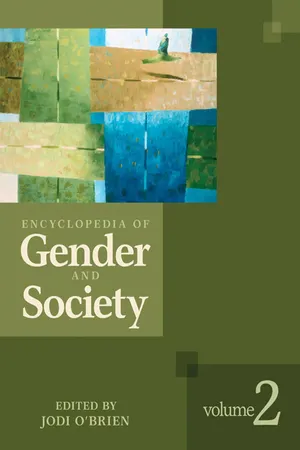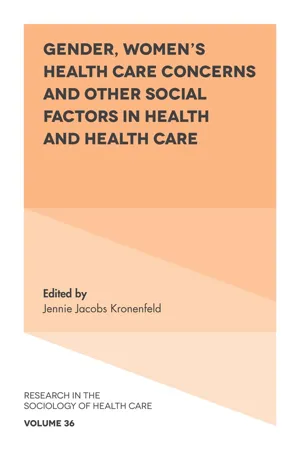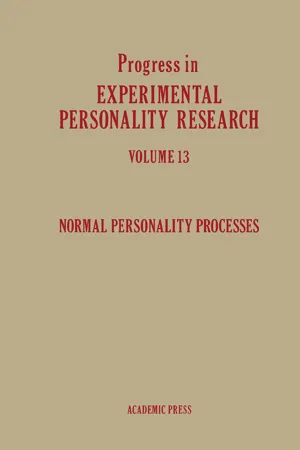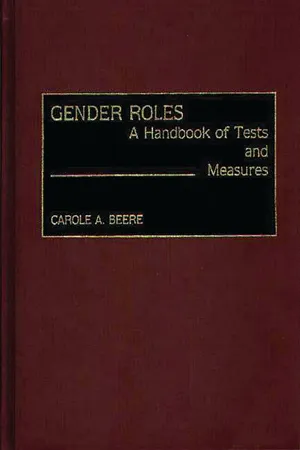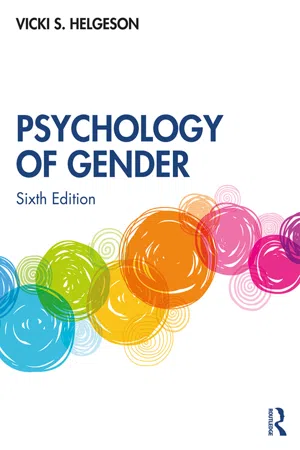Psychology
Bem Sex Role Inventory
The Bem Sex Role Inventory is a widely used measure of masculinity and femininity, developed by psychologist Sandra Bem. It assesses an individual's gender role orientation by measuring their identification with stereotypically masculine and feminine traits. The inventory consists of 60 items and provides scores for masculinity, femininity, and androgyny, allowing for a more nuanced understanding of gender identity.
Written by Perlego with AI-assistance
Related key terms
1 of 5
8 Key excerpts on "Bem Sex Role Inventory"
- eBook - PDF
- Jodi O'Brien, Jodi O′Brien, Jodi O'Brien(Authors)
- 2008(Publication Date)
- SAGE Publications, Inc(Publisher)
It is against this backdrop that Sandra L. Bem con-structed her Sex Role Inventory in 1974. Bem intended her inventory to represent two fully inde-pendent scales of culturally defined masculinity and culturally defined femininity. The BSRI is the most frequently used measure in sex role research and is 58 ——— Bem Sex Role Inventory used as a standard against which other instruments are compared. Construction of the BSRI In 1974, Bem and her students compiled a list of 200 personality characteristics that seemed positively val-ued and stereotypically masculine or feminine, as well as 200 other characteristics that seemed neither mas-culine nor feminine. Of those other characteristics, half were positively valued, and half were negatively valued. Bem and her students distributed the list of 400 items to two samples of Stanford University’s undergraduates. In each sample, half of the subjects of each sex rated each characteristic in terms of its sex-typed social desirability for a man, and the other half of the subjects rated each characteristic in terms of its desirability for a woman. The rating scale ranged from “Not at all desirable” to “Extremely desirable.” Personality characteristics that were judged as more desirable for a man than for a woman or more desirable for a woman than for a man qualified for inclusion in the masculinity and femininity scales, respectively. Of those eligible items, 20 were selected for each scale. Personality characteristics that were judged as no more desirable for one sex than the other qualified for inclusion in the social desirability scale. Of those, 10 positive and 10 negative characteristics were chosen. The final lists of the items included in each of the scales are presented in Table 1. - eBook - PDF
- Colin Hamilton(Author)
- 2008(Publication Date)
- Bloomsbury Academic(Publisher)
In addition 20 neutral items were identified. Bem subsequently employed these to construct the Bem Sex Role Inventory (BSRI). The BSRI was subsequently given to 356 women and 561 men (university and junior college participants) who were asked to rate the extent to which they possessed the 60 characteristics. The key feature of this approach is that participants, regardless of their sex, could possess characteristics stereotypically associated with both women and with men. Thus gender could be considered not to be a unidimensional but a multidimensional construct. Participants subsequently were rated as either feminine (endorsing feminine items more than masculine items) mas-culine (endorsing masculine items more than feminine), or androgynous (endorsing both feminine and masculine items). Note that the identification of an androgynous personality, the possession of both feminine and masculine items, could be evident only in a measure where masculine and feminine characteristics were measured independently. Bem observed that only about 21 per cent of the women endorsed a rela-tively high number of feminine characteristics and only about 13 per cent of the men endorsed significantly more masculine characteristics. This pattern of results suggests that the vast majority of women and men endorsed char-acteristics not stereotypically associated with their own sex. The pattern in Bem’s study strongly suggests that the possession of gender characteristics may vary considerably within women and within men. Bem developed her conceptualization of the BSRI by suggesting that per-formance on the inventory could give an indication of the individual’s gender schema (Bem 1981, 1985). This was a significant development in that it took a self-report measure which identified particular gender-labelled character-istics and considered this measure as a marker of how the individual could organize their social word through the ‘lens’ of a gender schema. - Jennie Jacobs Kronenfeld(Author)
- 2018(Publication Date)
- Emerald Publishing Limited(Publisher)
Carlsson, 2008 ).The BSRI is divided into masculine instrumental traits including taking the lead, being aggressive, competitive, dominant, self-reliant, and athletic; and feminine expressive traits including compassion, affection, sympathy, warmth, and being yielding (Bem, 1974, 1981 ). Bem hypothesized that:many individuals might be “androgynous”; that is, they might be both masculine and feminine, both assertive and yielding, both instrumental and expressive – depending on the situational appropriateness of these various behaviors. (1974 , p. 155)These androgynous people were considered adaptive, with better mental health than traditionally gendered individuals (Bem, 1977 ). The concept of androgyny was not accepted by all researchers (Flaherty & Dusek, 1980 ; Hyde & Phillis, 1979 ; Lott, 1981 ).The BSRI was originally divided into three subscales (Masculinity, Femininity, and Neutral), each with 20 items (Bem, 1974 ). The BSRI was developed by asking female and male judges to categorize traits as feminine or masculine. If a trait was independently categorized as masculine or feminine by judges, it was included in the BSRI (Bem, 1974 ). The BSRI has recently been revalidated with young adults (Kamas & Preston, 2012 ). Shorter versions of the BSRI exist, including one Bem (1981) chose to develop: a 30-item scale, with 10-items per subscale and the same 7-point Likert scales used in the 60-item version. A 12-item version of the BSRI (BSRI-12) was validated in English by Carver et al. (2013) . The BSRI-12 included the items: “gentle, sympathetic, leadership abilities, acts as a leader, dominant, tender, warm, affectionate, strong personality, defend own beliefs, sensitive to other’s need, and makes decisions easily” (Carver et al., 2013 , p. 2). In all versions of the BSRI, each construct is paired with a 7-point Likert scale: 1 signifying that a construct is “never” applicable and 7 representing that the construct is “always” applicable (Bem, 1974, 1981- eBook - PDF
Normal Personality Processes
Progress in Experimental Personality Research
- Brendan A. Maher, Winifred B. Maher(Authors)
- 2014(Publication Date)
- Academic Press(Publisher)
Other investigators, although not necessarily implicating genetic factors in their etiology, have evoked similar distinctions to explain specific phe- nomena, such as gender differences in the bases for moral judgments (Gil- ligan, 1982) or the failure of women to develop as strong task-oriented achievement motives as those of men and hence their lesser vocational at- tainments (Hoffman, 1975). The central explanatory role assigned by a number of psychological the- orists to gender differences in self-assertive and interpersonally oriented qualities provided the major initial impetus to the development of the PAQ as a vehicle for investigating empirically the contributions of these trait clus- ters to sex-role and other gender-related phenomena. B. Bem Sex Role Inventory (BSRI) 7. Description of the Scales Like the PAQ, the BSRI (Bem, 1974) is composed of two major scales, M and F. Each consists of 20 items accompanied by 7-point Likert scales. As Bem described the selection rationale, " a characteristic qualified as mas- culine if it was judged to be more desirable in American society for a man than for a woman, and it qualified as feminine if it was judged to be more desirable for a woman than a m a n " (1974, pp. 155-156). The M scale contains a substantial number of personality traits that are both self-assertive in nature and socially desirable to some degree, at least in men. Other types of items do not fit this description (e.g., analytic, ath- letic, masculine). The F scale is even more mixed in content. Although it includes a number of interpersonally oriented traits that are socially desir- able, at least in women, it also has other types of items (e.g., soft-spoken, does not use harsh language, feminine), and, inadvertently, several items that have been demonstrated (e.g., Pedhazur & Tetenbaum, 1979; Spence, Helmreich, & Holahan, 1979) to be considered socially undesirable, even in women (e.g., childlike, flatterable, gullible). - eBook - PDF
Gender Roles
A Handbook of Tests and Measures
- Carole A. Beere(Author)
- 1990(Publication Date)
- Greenwood(Publisher)
Interestingly, they found that the Sex Rep Test classified persons differently from the Bem Sex Role Inventory (BSRI) (Bem, 1974) (see separate entry) classified them. In a discriminant analysis, Baldwin et al. found that both Sex Rep Test scores and BSRI scores significantly predicted sex. Thus, both measures were related to sex but in nonoverlapping ways. NOTES & COMMENTS: (1) Role Construct Repertory Tests are not new; they have been around since the 1950s; however, the techniques have been used to measure sex role only fairly recently. These approaches have the advantage of allowing the respondent to provide his or her own definition of masculinity and femininity, and they avoid the prob- lems associated with norm-based measures that are culture bound or Gender Roles 169 time bound. Baldwin et al. (1986) presented data and arguments to support the superiority of the Sex Rep approach over the traditional approach used by Bem. (2) There are also disadvantages to the Role Construct approach. It is a very complicated procedure and lacks the simplicity of typical paper- and-pencil measures. Furthermore, the approach does not deal with problems of social desirability or response bias. In the Ravinder measure, for example, the respondent was asked to label 12 traits as masculine, feminine, or both, after having just indicated that the traits were self- descriptors. AVAILABLE FROM: Shashi Ravinder, University of Wollongong, New South Wales, Australia; Amy C. Baldwin, Department of Psychology, Northern Arizona University, Flagstaff, AZ 86011 USED IN: Baldwin, A. C, Critelli, J. W., Stevens, L. C, & Russell, S. (1986). Androgyny and sex role measurement: A personal construct approach. Journal of Per- sonality and Social Psychology, 51, 1081-1088. Ravinder, S. (1987a). An empirical investigation of Garnet's and Pleck's sex role strain analysis. - Pamela J. Kalbfleisch, Michael J. Cody(Authors)
- 2012(Publication Date)
- Routledge(Publisher)
The hypothetical masculinity-femininity continuum is essentially a static conception of the organization of gender-related characteristics. As we discussed earlier, association of the concept of sex-role identification with inventories purportedly measuring the masculinity-femininity construct implies the processes by which males high in masculinity and females high in femininity acquire and maintain the attributes and behaviors associated with their gender. Those who are strong in their sex-role identification, it is presumed, engage in an active, though not necessarily conscious, effort to shape themselves in their characteristics, attitudes, and role behaviors to resemble the expected member of their own age and sex, as defined by their culture or subculture. Although this may be the intent of Bern (1974) and others in using sex-role identification to describe what the BSRI and other similar inventories measure, these developmental implications have not been spelled out and are essentially ignored by most investigators.The term sex-role orientation, which arose as a label for the BSRI and PAQ, is even further shorn of dynamic meanings, serving simply as a rather empty alternative to the terms masculinity and femininity in describing what these questionnaires purportedly measure. In fact, reference to sex-role orientation almost always occurs in conjunction with these instruments.Two-Factor ModelPrior to the mid 1970s, occasional investigators proposed that masculinity and femininity constitute two independent continua (e.g., Jenkin & Vroegh, 1969). This proposition was essentially ignored until the appearance of the BSRI and PAQ. Studies with each of these instruments have consistently shown that their two gender-linked scales differentiate between men and women in the expected direction (e.g., Bern, 1974; Pedhazur & Tetenbaum, 1979; Spence & Helmreich, 1978; Spence et al., 1975). However, they have also shown that scores on the two scales of each instrument are nonsignificantly correlated. These findings have also been found in elementary school children responding to simpler versions of these instruments (e.g., Boldizar, 1991; Hall & Halberstadt, 1980; Simms et al., 1978; Spence & Hall, 1993). In response to these results, a number of commentators have continued to endorse the global concepts of masculinity and femininity but interpret the data as indicating that masculinity and femininity constitute two unrelated dimensions rather than a single bipolar one. Statements to this effect are quite common in psychology textbooks and other secondary sources.- Available until 11 Feb |Learn more
- Vicki S. Helgeson, Vicki S. Helgeson(Authors)
- 2020(Publication Date)
- Routledge(Publisher)
They saw a relation between superior power and instrumentality and a relation between inferior power and expressivity. They believed the distinction between the husband role and the wife role was both an instrumental/expressive distinction as well as a superior/inferior power distinction. The instrumental orientation became linked to the male gender role, and the expressive orientation became linked to the female gender role. Two instruments were developed during this period that linked the instrumental versus expressive orientation to gender role. In 1974, Sandra Bem published the Bem Sex Role Inventory (BSRI), and Spence, Helmreich, and Stapp published the Personal Attributes Questionnaire (PAQ). The BSRI and the PAQ are still the most commonly used inventories to measure masculinity and femininity today. The innovative feature of both instruments is that masculinity and femininity are conceptualized as two independent dimensions rather than a single bipolar scale; thus, a person receives a masculinity score and a femininity score. Masculinity and femininity were no longer viewed as opposites. The PAQ (Spence, Helmreich, & Stapp, 1974) was developed by focusing on the perception of how likely men and women are to possess certain traits. College students were asked to rate the typical adult male and female, the typical college male and female, and the ideal male and female. The items on this instrument are shown in Table 2.5. The masculinity scale included items that students viewed as more characteristic of men than women but also as ideal for both men and women to possess. “Independence” was a masculinity item; the typical college male was viewed as more independent than the typical college female, but independence was perceived as equally desirable in both men and women. The femininity scale included items that were more characteristic of women than men but viewed as ideal in both women and men - eBook - ePub
Women and Work
A Handbook
- Sonia Carreon, Amy Cassedy, Kathryn Borman, Paula J. Dubeck(Authors)
- 2013(Publication Date)
- Routledge(Publisher)
A major event of the 1970s research was the emergence of the concept of androgyny. Earlier research had focused upon the masculinity of males and the femininity of females, and some scales were bipolar in treating masculinity and femininity as opposite ends of a single dimension. In what became a series of landmark studies, Sandra Bern (1974) emphasized a scoring system (Bern Sex Role Inventory) encompassing both masculine and feminine traits that permitted the scoring of androgyny—that is, presence of both masculine and feminine characteristics in the same person. While her research was relatively limited methodologically and her findings not unequivocal, the concept had substantial appeal and dominated research interests of feminist scholars, who elaborated the advantages of flexibility and adaptability of the non-sex-typed personality (Kaplan and Bean 1976) and the psychological disadvantage of sex-typing (Franks and Rothblum 1983). However, as research on relations between androgyny, achievement, and well-being accumulated, it became clear that despite the intuitive validity of the concept, androgyny was not the advantage to mental health and achievement it had appeared to be. Rather, it was masculinity that was related to mental health. Androgyny was beneficial, especially for women, because it included masculinity, not because of the combination of femininity and masculinity (Cook 1985). Androgynous persons are better liked and have higher self-esteem, however.In addition to the focus on androgyny, other approaches have questioned the direct conceptualization of the stereotypes as consisting of masculinity and femininity, as Bern (1974) supposed. Factor analysis of the BSRI often reveals four dimensions. One is sex and a second is feminine expressiveness. The masculinity dimension bifurcates into two obvious, but not always recognized, dimensions: dominance and aggressiveness on the one hand and independence and self-sufficiency on the other. This factor structure appears to be remarkably stable across time (Waters and Popovich 1986).
Index pages curate the most relevant extracts from our library of academic textbooks. They’ve been created using an in-house natural language model (NLM), each adding context and meaning to key research topics.
